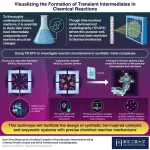(Press-News.org)
Immobilizing small synthetic molecules inside protein crystals proves to be a promising avenue for studying intermediate compounds formed during chemical reactions, report scientists from Tokyo Tech. By integrating this method with time-resolved serial femtosecond crystallography, they successfully visualized reaction dynamics and rapid structural changes occurring within reaction centers immobilized inside protein crystals. This innovative strategy holds significant potential for the intelligent design of drugs, catalysts, and functional materials.
Most complex chemical reactions, whether synthetic or biological, do not involve a direct transformation of reactants into products. Instead, they often proceed through the formation of short-lived intermediate compounds that undergo further reactions until the final products are obtained. Understanding these stepwise processes in detail is crucial for advancements in fields such as energy generation, catalysis, and medicine.
However, visualizing short-lived intermediates in chemical reactions is quite challenging, especially if one needs to capture structural changes in a molecule at the atomic level. One cutting-edge method to achieve this is time-resolved serial femtosecond crystallography (TR-SFX). This technique involves shooting extremely fast electron laser pulses at crystalized molecular structures and capturing the ensuing diffraction patterns. These molecular structures are in various stages of a chemical reaction, allowing the reaction dynamics to be recorded. Despite its astonishing capabilities, the use of TR-SFX thus far has been mostly limited to biomacromolecules.
To extend the applications of this powerful technique and showcase its potential for other types of molecules, a research team from Japan, led by Professor Takafumi Ueno, decided to use it to analyze reactions in synthetic compounds. Using an innovative approach, they successfully captured the dynamics of carbon monoxide (CO) release from Mn(CO)3. Their study was published on <date placeholder> in Nature Communications.
One significant limitation that the researchers had to overcome is the fact that TR-SFX works best with microcrystals, such as those formed by biomacromolecules. Additionally, although small molecules can form crystals suitable for TR-SFX, these crystals are generally tightly packed, leaving little room for reactions to occur.
To address these issues, the team developed an innovative strategy based around hen egg-white lysozyme (HEWL). This naturally occurring protein not only crystallizes into a nanoporous structure suitable for TR-SFX, but also contains His15 terminals that bind strongly to metals. The researchers took advantages of these properties to immobilize a light-sensitive Mn(CO)3-containing compound inside HEWL crystals. This setup provided a suitable environment for studying CO release reactions, which were triggered by shooting light pulses at the crystals at carefully controlled time intervals relative to the TR-SFX electron laser pulses.
Overall, this protocol proved highly promising for investigating the target reaction by analyzing changes in electron density maps obtained via TR-SFX. “After CO release, Mn centers typically undergo dimerization, aerial oxidation or precipitation in solution, which complicates mechanistic investigations. In our work, by isolating the Mn reaction centers in a restricted protein environment, we enabled a detailed experimental analysis of the intermediates generated during the progression of the reaction,” explains Ueno.
Worth noting, the experimental results were in excellent agreement with quantum mechanical calculations, validating the proposed strategy. “We have established that, by using protein crystals as a matrix, the reactions of synthetic metal complex can be studied, including the determination of any intermediate structures,” concludes Ueno, “This advancement holds the potential to facilitate the design of artificial metalloenzymes with precise mechanisms, empowering the design, control, and development of innovative reactions.”
In conclusion, the method developed in this work provides an avenue for the smart design of new drugs, catalysts, and enzymatic systems involving non-biological components. Let us hope this new tool pushes many applied fields further towards next-generation technologies!
###
About Tokyo Institute of Technology
Tokyo Tech stands at the forefront of research and higher education as the leading university for science and technology in Japan. Tokyo Tech researchers excel in fields ranging from materials science to biology, computer science, and physics. Founded in 1881, Tokyo Tech hosts over 10,000 undergraduate and graduate students per year, who develop into scientific leaders and some of the most sought-after engineers in industry. Embodying the Japanese philosophy of “monotsukuri,” meaning “technical ingenuity and innovation,” the Tokyo Tech community strives to contribute to society through high-impact research.
https://www.titech.ac.jp/english/
END
Prejudice against fat people is endemic in our society and public health initiatives aimed at reducing obesity have only worsened the problem, according to a U.S. academic.
In her new book Why It’s OK To Be Fat, Rekha Nath, an Associate Professor of Philosophy at the University of Alabama, argues for a paradigm shift in how society approaches fatness.
According to Nath, society must stop approaching fatness as a trait to rid the population of, and instead fatness should be approached through the lens of social equality, attending to the systematic ways that society penalizes fat people for their body size.
Nath explains: “Being fat is seen as unattractive, as gross even. ...
Up on the “roof of the world”, one of the world’s largest ecosystem restoration projects is taking place. The Qinghai-Tibetan Plateau (QTP) in western China is the world’s highest plateau and covers a land area roughly five times the size of France.
Home to thousands of rare plants and wildlife and the source of water for more than 2.5 billion people, this vital ecosystem is under threat.
The region’s grassland is degrading due to climate change and intense livestock grazing. Government ...
In a new study of politicians’ personalities, humour, charm and raw courage are listed among the most important character traits for successful leaders.
Bill Jones, Honorary Professor of Political Studies at Liverpool Hope University, has combed through biographies and interviewed key political figures to understand the kind of people who enter politics, and strengths and frailties of those who occupy positions of power.
Jones explains: “Why do aspiring politicians embark on such a perilous journey, involving hugely long hours, no real job security and, on occasions, high degrees ...
A pioneering study, presented today at the ESHRE 40th Annual Meeting in Amsterdam, has revealed that exposure to fine particulate matter (PM) prior to the retrieval of oocytes (eggs) during in vitro fertilisation (IVF) can reduce the odds of achieving a live birth by almost 40% [1].
The study analysed PM10 exposure in the two weeks leading up to oocyte collection, finding that the odds of a live birth decreased by 38% (OR 0.62, 95% CI 0.43-0.89, p=0.010) when comparing the highest quartile of exposure (18.63 to 35.42 µg/m3) to the lowest quartile (7.08 to 12.92 µg/m3).
Conducted ...
Gestational carriers, also known as surrogates, experience an elevated risk of severe maternal morbidity and adverse pregnancy outcomes compared to women who conceive naturally or through in vitro fertilisation (IVF), according to new research presented today at the ESHRE 40th Annual Meeting in Amsterdam [1].
The population-based study analysed 937,938 singleton births in Ontario, Canada between 2012 and 2021, comparing outcomes among unassisted conceptions, IVF conceptions and gestational carriers.
The findings uncovered marked variations in outcomes across the different conception methods. Gestational carriers faced a severe maternal morbidity rate ...
New research has demonstrated the effectiveness of a first-in-class oral, non-hormonal drug in increasing embryo implantation, pregnancy and live birth rates among infertile women who are undergoing in vitro fertilization (IVF) or intracytoplasmic sperm injection (ICSI) [1]. The findings, presented today at the ESHRE 40th Annual Meeting in Amsterdam, represent a significant step toward the first therapeutic tool to increase embryo implantation and live birth rate success.
Worldwide, one ...
A breakthrough for biomedical research promises new insight into immunotherapy development and disease modeling. Scientists at The University of Texas Health Science Center at San Antonio have created a humanized mouse model with a human immune system and a human-like gut microbiome that is capable of mounting specific antibody responses.
The scientists were led by Paolo Casali, MD, University of Texas Ashbel Smith Professor and Distinguished Research Professor, Department of Microbiology, Immunology and Molecular Genetics in the Joe R. and Teresa Lozano Long School of Medicine. Casali has five decades of biomedical research ...
At the upcoming SIAM Conference on Mathematics of Data Science (MDS24), a diverse mix of professionals from universities, industry, government, and research labs are set to join. The conference will showcase cutting-edge research that advances mathematical, statistical, and computational methods in the context of what we do with data and how to do it better. Presentations will range from foundational theory of data science to diverse applications. A particular focus this year is on the interaction of data science with the broader society in terms of privacy, interpretability, explainability, ...
Over 5,000 genetic variants that enable certain cancers to thrive have been identified by scientists, along with a potential therapeutic target to treat or even prevent these cancers from developing.
Researchers from the Wellcome Sanger Institute, and their collaborators at The Institute of Cancer Research, London and the University of Cambridge assessed the health impact of all possible genetic changes in the ‘tumour protection’ gene, BAP1. They found around a fifth of these possible changes were pathogenic, significantly increasing the risk of developing ...
Texas Tech University’s Qingwang Yuan, an assistant professor in the Bob L. Herd Department of Petroleum Engineering, has received a grant from the U.S. Department of Energy’s (DOE) Office of Fossil Energy and Carbon Management (FECM).
Yuan and Texas Tech will take the lead on a project titled, “Incubating Next Generation Clean Energy Scientists and Engineers Through Minority-Scholar Exchange and In-Situ Hydrogen Production Research.”
The research will be funded as part of an investment of more than $17 million from the DOE into 19 early-stage ...




